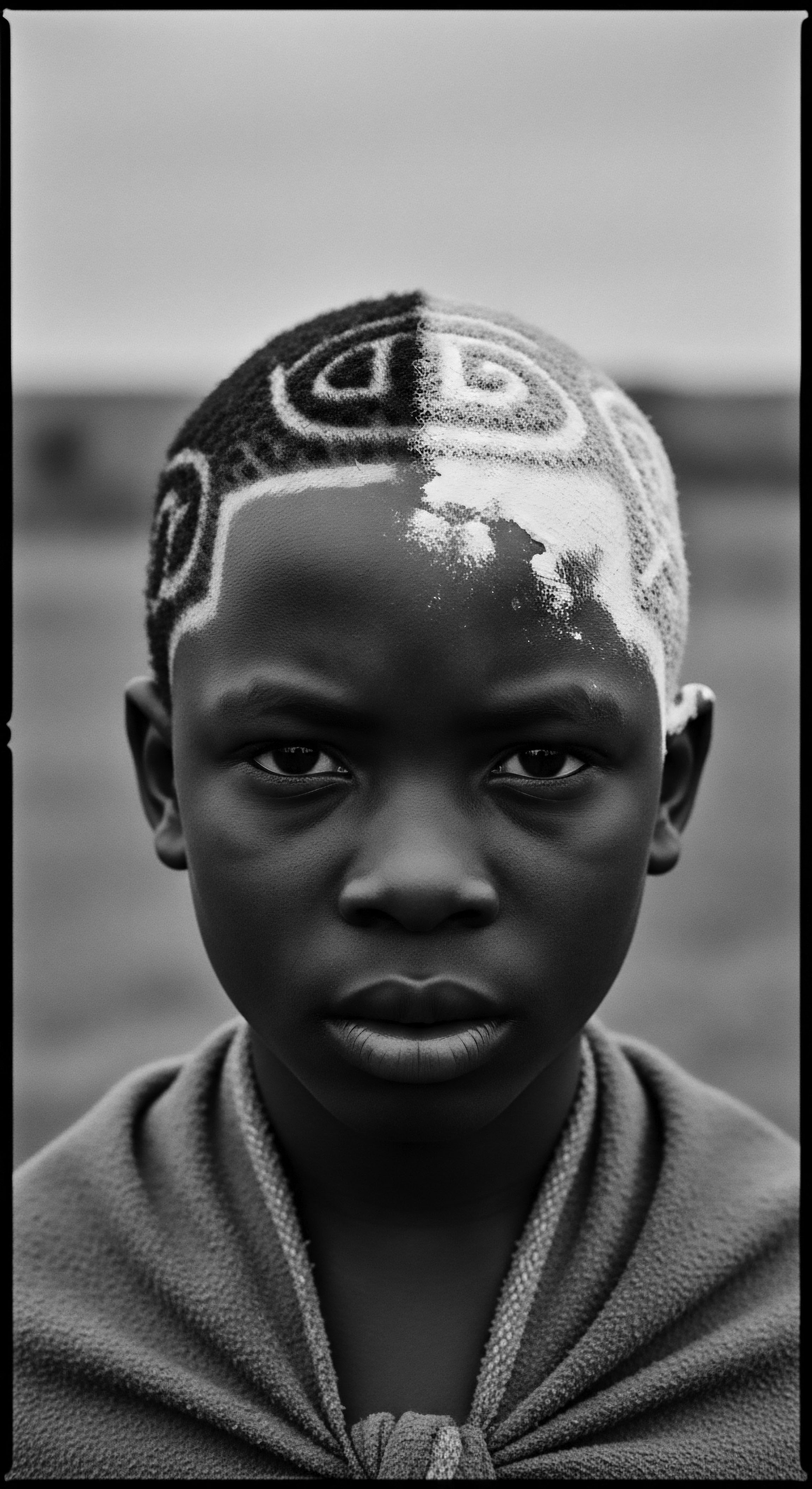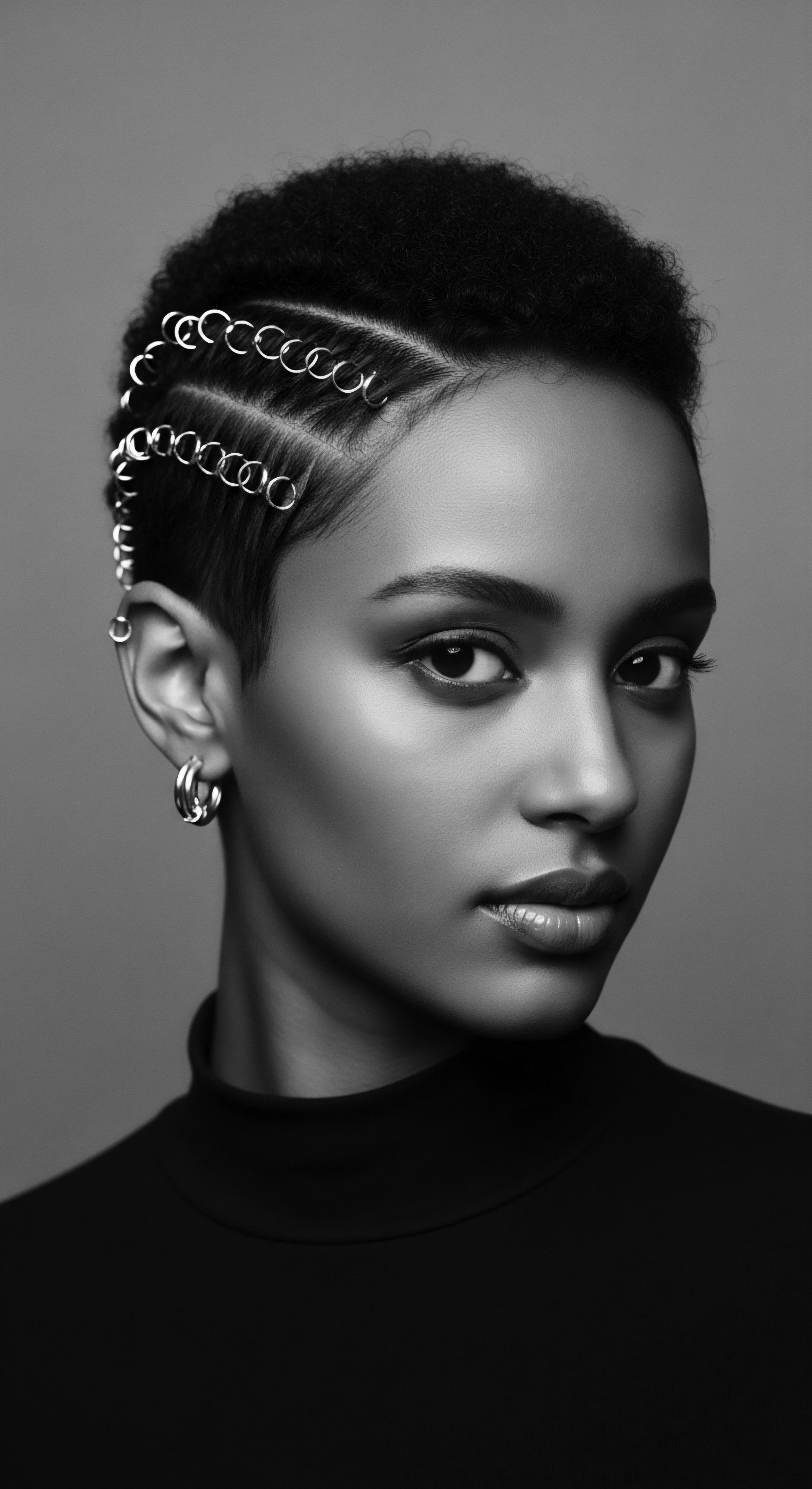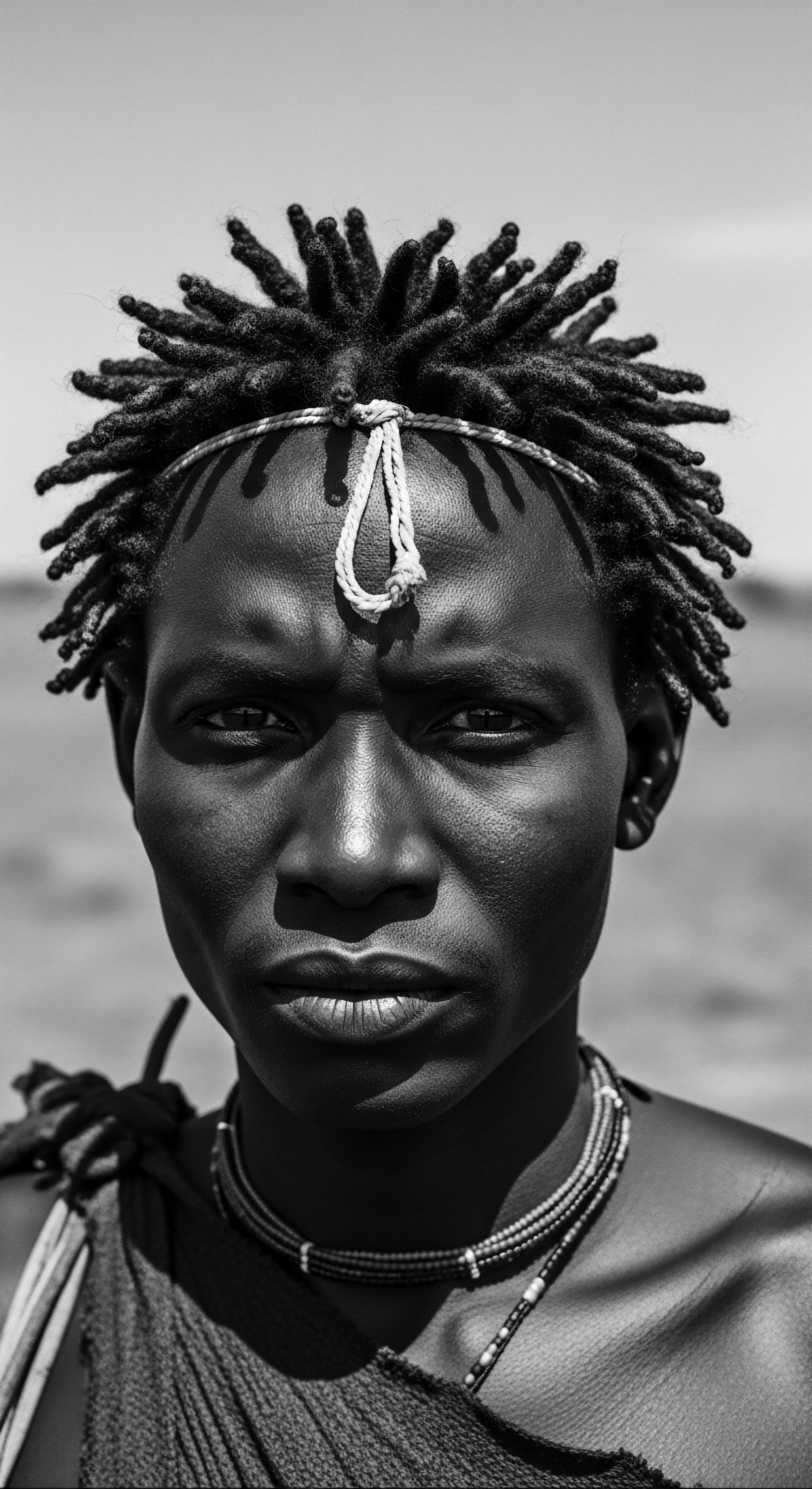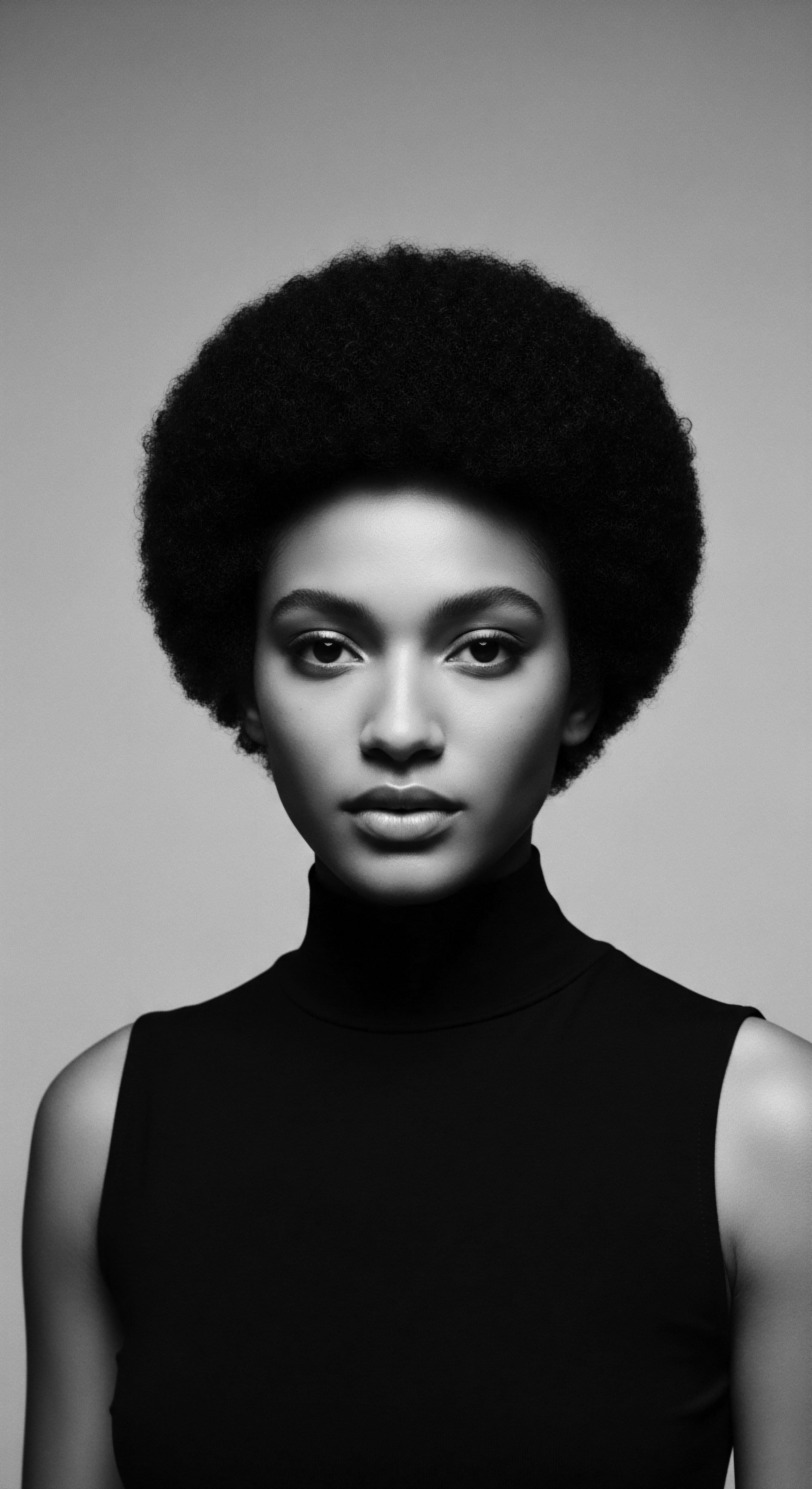
Fundamentals
The concept of Ancient African Beauty extends far beyond superficial adornment; it represents a profound spiritual, social, and cultural connection to the self and community, with textured hair serving as a central pillar. This interpretation, or Delineation, is deeply rooted in ancestral wisdom and the lived experiences of African peoples across millennia. It is a vibrant expression of identity, a visual language spoken through coils, curls, and intricate styles. From the earliest epochs, hair in African societies was not merely a physical attribute; it was a revered conduit to the divine, a marker of social standing, and a living chronicle of personal and communal history.
Understanding this beauty requires acknowledging the inherent qualities of Afro-textured hair, a marvel of biological architecture. Its unique helical structure, characterized by tight coils and varying densities, demands a particular kind of care, one that ancient African communities perfected through generations of observation and ingenuity. This inherent structure, often viewed with misunderstanding in later historical contexts, was celebrated and honored in its original settings. The methods developed to cleanse, nourish, and adorn this hair speak to a deep respect for its distinct needs and its symbolic weight.
Ancient African Beauty is a holistic understanding of self, community, and spirit, expressed profoundly through the revered heritage of textured hair.
The foundational Meaning of Ancient African Beauty, particularly concerning hair, rests upon several interwoven tenets ❉

Hair as a Chronicle of Identity
In many pre-colonial African societies, hairstyles served as an immediate visual lexicon, communicating a person’s age, marital status, tribal affiliation, social rank, wealth, and even religious beliefs. This profound connection meant that a single coiffure could convey volumes about an individual’s place within their community. For example, specific patterns of braids might indicate a woman’s readiness for marriage, or a man’s role as a leader or warrior. The care and attention given to hair were thus direct reflections of one’s identity and communal belonging.
The intricate art of hair styling was often a communal activity, a time for sharing stories, wisdom, and strengthening social bonds. This collective grooming ritual reinforced kinship ties and passed down cultural knowledge from elders to younger generations. The very act of tending to another’s hair became a tender exchange of affection and communal solidarity, reinforcing the collective spirit that characterized many African societies. This practice highlights how personal care was intrinsically linked to collective well-being.

Echoes from the Source ❉ Elemental Biology and Ancient Practices
The inherent qualities of textured hair, with its unique curl patterns and natural dryness, led ancestral African communities to develop sophisticated care regimens. These practices were born from an intuitive understanding of the hair’s elemental biology. They utilized ingredients sourced directly from the earth, recognizing their nourishing and protective properties. This natural wisdom, honed over centuries, formed the bedrock of Ancient African Beauty practices.
- Shea Butter ❉ Derived from the nuts of the African shea tree, this rich emollient was a cornerstone of ancient hair care, prized for its moisturizing and protective qualities. Its presence in hair rituals across West Africa speaks to its enduring value.
- Chebe Powder ❉ Originating from Chad, this blend of herbs and seeds, traditionally applied to hair, was used to strengthen strands and aid in length retention, reflecting a deep understanding of hair integrity.
- African Threading ❉ Known as “Irun Kiko” among the Yoruba people, this technique involved wrapping hair tightly with thread, a method used to stretch hair, protect it from breakage, and create intricate styles.
These practices, far from being mere fads, represented a scientific approach to hair care, albeit one grounded in traditional ecological knowledge rather than modern laboratory methods. The Clarification of Ancient African Beauty starts with recognizing this profound connection between the earth’s offerings and hair’s needs.

Intermediate
Expanding upon the foundational tenets, the intermediate Description of Ancient African Beauty delves deeper into its cultural applications and the resilience embedded within its historical trajectory. This understanding moves beyond simple definitions, inviting contemplation of how these practices, traditions, and the very perception of textured hair evolved through time, particularly in response to external pressures. The aesthetic was not static; it was a living, breathing testament to adaptation and persistence.

The Tender Thread ❉ Living Traditions of Care and Community
The communal aspect of hair care in ancient Africa was not simply a convenience; it was a sacred social ritual. Hours spent styling hair became opportunities for storytelling, mentorship, and the transmission of ancestral wisdom. This shared experience strengthened familial bonds and reinforced community cohesion.
It was a space where the wisdom of elders flowed to younger generations, where cultural narratives were passed down, and where identity was collectively affirmed. The Significance of these moments cannot be overstated, as they built the very fabric of social connection.
Hair grooming in ancient African societies was a communal ritual, weaving social bonds and transmitting ancestral wisdom across generations.
Specific hair styles, often painstakingly created, served as intricate maps of social identity. For instance, among the Wolof of Senegal, partially shaved hair on young girls could signify they were not yet courting, while the Karamo people of Nigeria were recognized by their unique coiffure of a shaved head with a single tuft remaining. These visual cues were universally understood within communities, allowing for immediate recognition of an individual’s standing and history.
The tools used in these practices were also imbued with cultural Meaning. Combs, often carved from wood, bone, or ivory, were not just functional items; they were works of art, sometimes engraved with symbols denoting tribal identity, rank, or protection. Archaeological finds from Kush and Kemet (ancient Sudan and Egypt) reveal these combs buried with their owners, underscoring the sacred regard for hair and its implements.
| Tool Afro Comb (Wide-tooth pick) |
| Traditional Use Detangling, shaping voluminous styles, symbolizing pride and status. |
| Contemporary Connection Modern detangling and styling, cultural affirmation, political statement. |
| Tool Hair Threading Needles/Threads |
| Traditional Use Stretching hair, protecting ends, creating specific elongated styles. |
| Contemporary Connection Heatless stretching, protective styling, maintaining length and hair health. |
| Tool Wooden or Bone Hairpins |
| Traditional Use Securing elaborate updos, adornment, ritualistic placement. |
| Contemporary Connection Styling, decorative elements, honoring ancestral aesthetic. |
| Tool These tools bridge ancient ingenuity with present-day hair care, reflecting a continuous respect for textured hair. |

The Spiritual Connection of Hair
Many African cultures held a profound belief that hair, as the highest point of the body, served as a direct connection to the spiritual realm and ancestral spirits. This belief permeated daily practices and ritualistic observances. For the Yoruba, hair was considered the most elevated part of the body, and braided styles were sometimes used to convey messages to the gods. This spiritual Connotation imbued hair with a sacred quality, dictating how it was handled, styled, and adorned.
The natural upward growth of Afro-textured hair, often forming a crown-like shape, was seen by some as an antenna, aiding in spiritual awareness and the reception of cosmic energy. This perspective elevates hair beyond mere aesthetics, positioning it as a vital component of one’s spiritual being and connection to the universe. Such a worldview meant that hair was not to be trifled with; its care was a solemn duty, a dialogue with the divine.

Academic
The academic Interpretation of Ancient African Beauty transcends a mere historical recounting; it demands a rigorous examination of its ontological foundations, its complex interplay with identity formation, and its enduring resilience against centuries of attempted erasure. This comprehensive Elucidation reveals a sophisticated system of aesthetics, social communication, and spiritual connection, predominantly articulated through textured hair. It is a profound declaration of being, a living archive inscribed upon the very strands of African and diasporic peoples. The meaning is not singular but a dynamic construct, constantly re-affirmed and re-imagined.
At its core, Ancient African Beauty represents a self-referential system of aesthetic valuation that predates and stands in stark contrast to Eurocentric ideals. This system recognized and celebrated the unique qualities of textured hair – its varying curl patterns, its ability to hold intricate styles, and its natural volume – as intrinsic aspects of allure and cultural wealth. This perspective is a critical lens through which to understand the profound impact of subsequent colonial and enslavement periods, which systematically sought to dismantle this indigenous appreciation. The very concept serves as a counter-narrative to imposed standards.

The Unbound Helix ❉ Voicing Identity and Shaping Futures
The forced removal of Africans from their homelands during the transatlantic slave trade brought about a devastating assault on their cultural identity, with hair becoming a primary target. Slave traders often shaved the heads of captured Africans, a deliberate act designed to dehumanize and sever their ties to community and heritage. This brutal act aimed to strip away the intricate language of hair, rendering individuals anonymous and culturally dispossessed. Despite this systemic oppression, the ancestral memory of hair care persisted, adapting and transforming into powerful acts of resistance.
The forced shaving of African hair during enslavement was a calculated act of cultural erasure, yet ancestral practices persisted as symbols of resilience.
The resilience of African hair traditions in the face of immense adversity is a testament to the enduring power of cultural memory. Even under brutal conditions, enslaved Africans found clandestine ways to preserve and adapt their hair practices. This adaptation speaks to the inherent human need for self-expression and cultural continuity.
For instance, the practice of braiding rice seeds into hair by West African women, particularly rice farmers, served as a covert means of survival, allowing them to carry sustenance and preserve a piece of their homeland. This powerful act highlights how hair became a silent, yet potent, tool for survival and cultural preservation.
Furthermore, specific braiding patterns became coded messages. Historical accounts suggest that certain cornrow designs functioned as maps to freedom, guiding enslaved individuals along escape routes. This remarkable instance of hair as a tool for resistance demonstrates its unparalleled Designation as a vehicle for survival and defiance. This complex system of communication, hidden in plain sight, speaks to the profound ingenuity and unwavering spirit of those who sought liberation.
(Omotos, 2018, p. 74),
The continued stigmatization of Afro-textured hair, a legacy of colonial beauty standards, has had demonstrable psychological and social consequences within Black and mixed-race communities. A 2017 study, “The ‘Good Hair’ Study,” examined explicit and implicit attitudes toward the hair of women of African descent in the United States. The findings revealed that Afro hairstyles were often perceived as less attractive and less professional compared to straight hair.
This internalized perception, a direct result of historical oppression, unfortunately continues to influence beauty standards and professional opportunities for many individuals today. This data underscores the ongoing struggle for acceptance and celebration of natural textured hair in contemporary society.

Reclamation and Re-Interpretation in the Modern Era
The mid-20th century witnessed a powerful resurgence of pride in African heritage, often expressed through hair. The Civil Rights Movement and Black Power Movement saw the Afro hairstyle emerge as a potent symbol of Black pride, unity, and resistance against Eurocentric beauty norms. Figures like Angela Davis and Nina Simone popularized the Afro, transforming it from a mere hairstyle into a political statement. This period marked a deliberate reclaiming of ancestral aesthetics and a rejection of imposed standards.
The modern natural hair movement, which gained significant momentum in the late 2000s, continues this legacy of reclamation. It represents a collective decision to embrace and celebrate natural textures, challenging discriminatory practices and promoting inclusivity within the beauty industry. Social media platforms have played a vital role in this movement, creating vibrant online communities where individuals share care tips, celebrate their hair journeys, and find inspiration, bridging ancestral traditions with contemporary expressions. This ongoing movement re-affirms the Substance of Ancient African Beauty, not as a relic of the past, but as a dynamic and evolving force.
The meaning of Ancient African Beauty today extends to its scientific validation. Many traditional African hair care practices, once dismissed, are now recognized for their efficacy by modern science. The protective qualities of braiding and threading, for instance, which minimize manipulation and promote length retention, align with contemporary understanding of hair health.
The moisturizing properties of natural ingredients like shea butter are now globally recognized. This confluence of ancient wisdom and modern scientific understanding further solidifies the enduring value of these ancestral approaches.
The continuous evolution of hairstyles within the African diaspora speaks to the adaptability and creativity inherent in this heritage. Styles like Bantu knots, cornrows, and locs, rooted in ancient practices, are constantly re-interpreted and reimagined, demonstrating a living, breathing connection to the past while simultaneously shaping the future of textured hair aesthetics. This dynamic interplay between tradition and innovation defines the contemporary Essence of Ancient African Beauty.
The concept of Ancient African Beauty, therefore, is a multifaceted Explication of cultural identity, spiritual connection, and enduring resilience. It serves as a powerful reminder that beauty is not monolithic, but a rich tapestry woven from diverse histories, ancestral practices, and collective affirmations. Its study reveals not only the historical experiences of African peoples but also offers profound insights into the universal human need for self-expression, cultural preservation, and the reclamation of one’s authentic self. This academic inquiry into Ancient African Beauty contributes significantly to a more inclusive and historically accurate understanding of global aesthetics and human heritage.

Reflection on the Heritage of Ancient African Beauty
The whispers of ancient winds carry the stories of coils and crowns, echoing through generations. As we contemplate the vast Delineation of Ancient African Beauty, we perceive more than historical practices; we perceive a living heritage, a continuous flow of wisdom that nourishes the very Soul of a Strand. This profound concept is not confined to dusty museum displays or academic texts alone; it lives within every strand of textured hair, within every shared styling moment, and within every decision to honor ancestral ways. It is a testament to the enduring spirit of a people whose relationship with their hair was, and remains, a sacred dialogue with identity and the divine.
The understanding of Ancient African Beauty beckons us to look inward, to acknowledge the deep historical roots that ground our present experiences with textured hair. It reminds us that the challenges faced by Black and mixed-race hair experiences today are not isolated incidents but echoes of historical injustices, particularly the systematic attempts to dismantle this profound connection. Yet, within this acknowledgment lies immense strength. The resilience demonstrated by our ancestors, who transformed acts of oppression into symbols of resistance and survival through their hair, lights a path for contemporary reclamation.
To truly appreciate Ancient African Beauty is to celebrate the ingenuity of those who first learned to care for textured hair with such profound wisdom, utilizing the earth’s bounty to create regimens that supported its unique structure. It is to honor the communal spaces where hair was tended, stories exchanged, and bonds solidified. It is to recognize that our hair, in its natural state, is a crown, a map, a spiritual antenna, and a vibrant declaration of who we are and from whom we descend. The journey of Roothea, then, becomes a continuous act of reverence, a dedication to preserving and sharing this invaluable heritage, ensuring that the ancient echoes continue to inspire and guide the future of textured hair care and self-acceptance.

References
- Byrd, A. & Tharps, L. L. (2014). Hair Story ❉ Untangling the Roots of Black Hair in America. St. Martin’s Griffin.
- Gordon, M. (2018). The Symbolic Significance of Hair in Traditional African Culture. Journal of Pan African Studies, 11(7), 65-80. (Referenced in Omotos, 2018, as cited in)
- Omotos, A. (2018). The Significance of Hair in Ancient African Civilizations. Journal of Pan African Studies, 11(7), 71-85.
- Sherrow, V. (2006). Encyclopedia of Hair ❉ A Cultural History. Greenwood Press.
- Wade, P. (2002). Race, Nature, and Culture ❉ An Anthropological Perspective. Pluto Press.
- Davis, A. Y. (1971). Angela Davis ❉ An Autobiography. Random House.
- hooks, b. (1992). Black Looks ❉ Race and Representation. South End Press.
- White, L. (2000). Speaking with Vampires ❉ Rumor and History in Colonial Africa. University of California Press.
- Byrd, A. & Tharps, L. L. (2001). Hair Story ❉ Untangling the Roots of Black Hair in America. St. Martin’s Press. (Cited in, )
- Banks, I. (2000). Hair Matters ❉ Beauty, Power, and Black Women’s Consciousness. New York University Press.
- Mercer, K. (1994). Welcome to the Jungle ❉ New Positions in Black Cultural Studies. Routledge.
